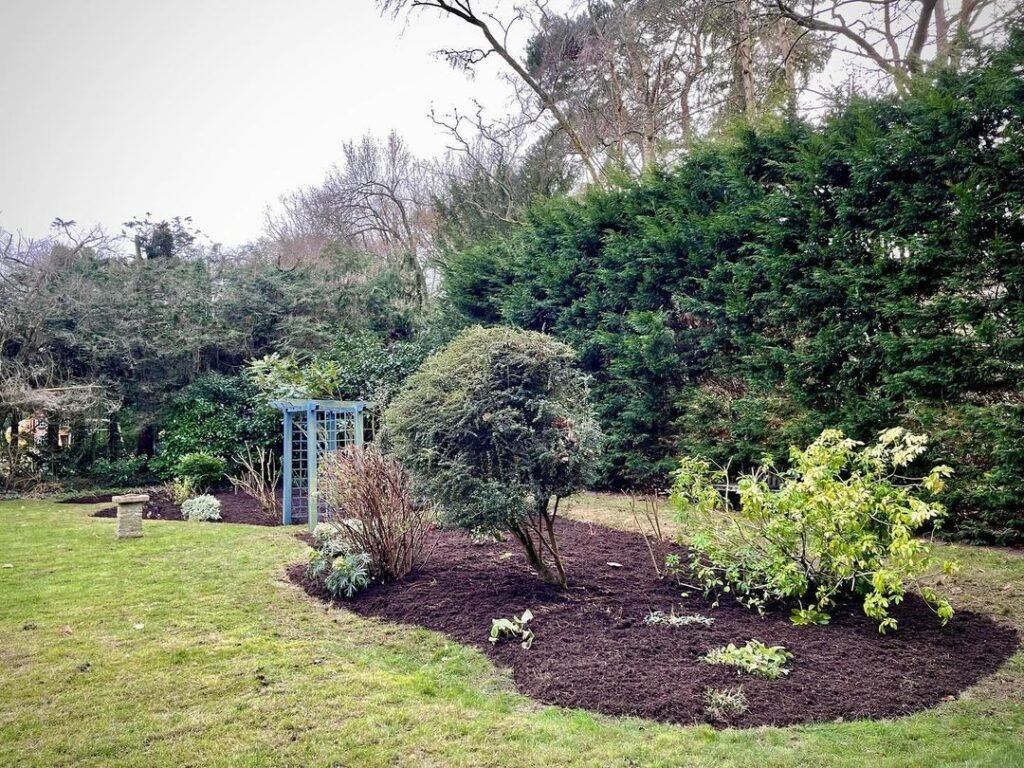Mulching stands out as one of the top practices to elevate your garden’s health and aesthetics. It’s a multitasker, conserving soil moisture, thwarting weeds, moderating soil temperature, preventing erosion, and enriching soil with organic goodness. Plus, it lends a neat and appealing look to your garden.

However, determining the ideal quantity of mulch for your garden beds poses a conundrum. Too little won’t deliver the desired benefits, while an excess could suffocate your plants, leading to issues like rot, pests, and diseases. That’s why getting the right balance is crucial.
In this guide, we’ll walk you through using a simple mulch calculator to ascertain the precise amount of mulch your garden requires. Additionally, we’ll provide insights on selecting the appropriate mulch type and applying it correctly.
How to Utilize a Mulch Calculator:
A mulch calculator serves as a nifty tool to estimate the amount of mulch needed based on your garden bed’s dimensions and desired depth. You can opt for an online mulch calculator or perform the calculations manually using this formula:
Mulch Volume (cubic feet) = Area (square feet) x Depth (inches) / 12
To apply this formula, start by measuring the length and width of your garden bed in feet and multiplying these figures to obtain the area in square feet. Next, decide on the desired depth of your mulch layer in inches. Typically, mulch depth ranges from 2 to 4 inches, depending on the mulch type and your plant species. Finally, divide the product of the area and depth by 12 to determine the volume of mulch in cubic feet.

For instance, if your garden bed measures 10 feet in length and 5 feet in width, and you aim for a 3-inch mulch layer, perform the following calculation:
Mulch Volume (cubic feet) = (10 x 5) x 3 / 12
Mulch Volume (cubic feet) = 50 x 3 / 12
Mulch Volume (cubic feet) = 150 / 12
Mulch Volume (cubic feet) = 12.5
This indicates that you’ll need 12.5 cubic feet of mulch for your garden bed.
If you wish to convert the mulch volume from cubic feet to cubic yards, divide it by 27 since there are 27 cubic feet in one cubic yard. For example, 12.5 cubic feet of mulch equals 0.46 cubic yards of mulch.
Mulch Volume (cubic yards) = Mulch Volume (cubic feet) / 27
Mulch Volume (cubic yards) = 12.5 / 27
Mulch Volume (cubic yards) = 0.46
This conversion proves handy when purchasing mulch in bulk, as it’s typically sold by the cubic yard.
Houseplant Pest Control: A Comprehensive Guide
Selecting the Right Mulch Type:
An array of mulch types is available, each with its unique attributes, advantages, and drawbacks. Common options include:
Organic mulch:

Crafted from natural materials like wood chips, bark, straw, leaves, grass clippings, compost, or pine needles, organic mulch decomposes over time, enriching the soil with nutrients and organic matter. It also attracts beneficial organisms that enhance soil health and structure.
Inorganic mulch:

Comprising synthetic or non-biodegradable materials such as gravel, stone, rubber, plastic, or fabric, inorganic mulch doesn’t break down or add nutrients to the soil. However, it boasts longevity and requires less maintenance than organic mulch, offering benefits like soil erosion prevention and heat/light reflection.
choice of mulch hinges on personal preferences, budget, availability, and your plants’ and soil’s requirements. Consider factors such as –
Color:
The hue of the mulch influences your garden’s aesthetics and soil temperature. Dark-colored mulch absorbs heat, suitable for cooler climates or heat-loving plants, while light-colored mulch reflects light, ideal for warmer climates or plants that thrive in cooler soil.
Texture:
Mulch texture affects soil moisture retention and drainage. Fine-textured mulch retains moisture, beneficial for dry soil or water-loving plants, whereas coarse-textured mulch facilitates drainage, suitable for clayey soil or plants requiring well-drained conditions.
pH:
Mulch pH impacts soil acidity or alkalinity. Acidic mulch lowers soil pH, advantageous for acid-loving plants, while alkaline mulch raises soil pH, beneficial for alkaline-loving plants.
Cocopeat: The Green Gardener’s Secret Weapon
Applying Mulch Properly:
Proper mulch application is key to maximizing its benefits and avoiding potential issues. Follow these steps:
Soil preparation:
Clear the soil of weeds, debris, and rocks, and loosen compacted areas before mulching. Ensure the soil is moist and evenly hydrated.
Even distribution:
Spread mulch evenly over the soil surface using a rake, shovel, or your hands. Avoid forming mulch mounds, as they hinder air and water penetration. Leave space around plant bases to prevent rot, disease, or pest infestation.
Check depth:
Verify mulch depth using a ruler or your finger. Adjust the depth as needed, aiming for 2 to 4 inches to strike the right balance between benefits and potential problems.
Maintenance:
Regularly check and replenish mulch as necessary. Organic mulch requires replacement every 1-2 years, while inorganic mulch lasts longer but may require cleaning or refreshing. Fluff mulch occasionally to prevent compaction and enhance aeration.
Optimizing Your Garden for Potato Bug Control
Mulching emerges as a simple yet potent method to enhance your garden’s vitality and visual appeal. Utilize a mulch calculator to determine the optimal amount of mulch for your garden beds. By selecting the right mulch type and applying it correctly, you can harness the benefits of mulching while sidestepping potential pitfalls. Happy mulching!
Pingback: Philodendron Silver Sword Care Guide -
Pingback: How to Grow Lots of Ginger in Containers -
Pingback: Creating a Vegetable Garden: Easy Vegetables to Grow
Pingback: The Low-Maintenance Way to Grow Flawless Mexican Feather Grass Gardener's School -
Pingback: Orchids Care & Growing Guide : A Beginner’s Handbook for Beautiful Blooms
Pingback: Everything You Need to Know to Grow Monstera Deliciosa fruit